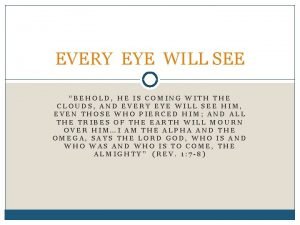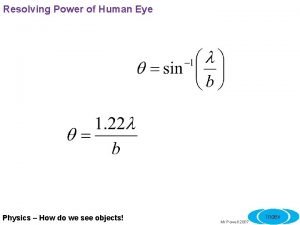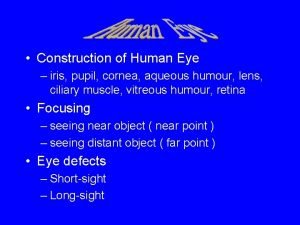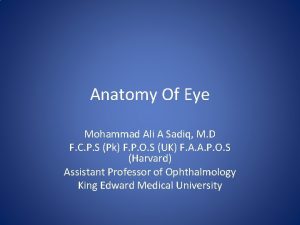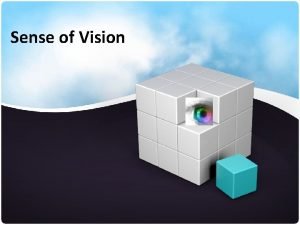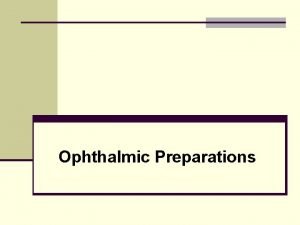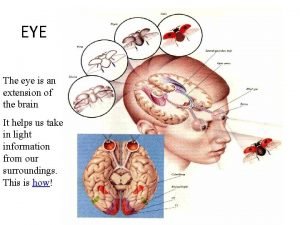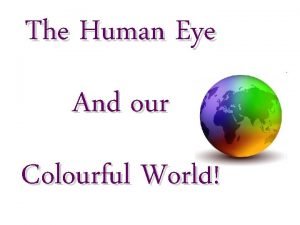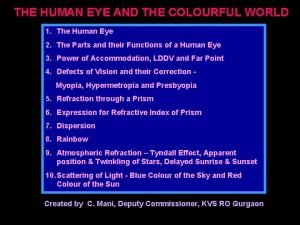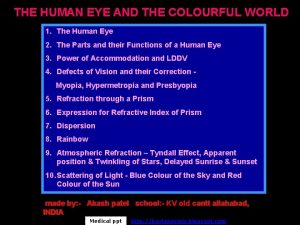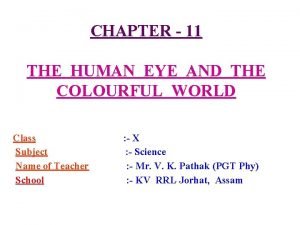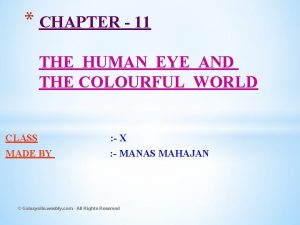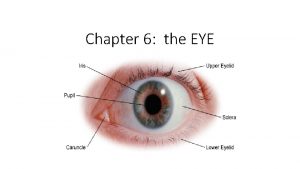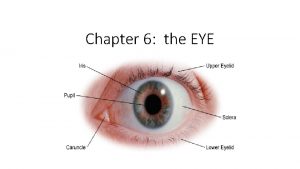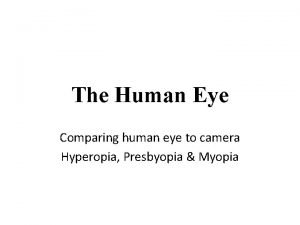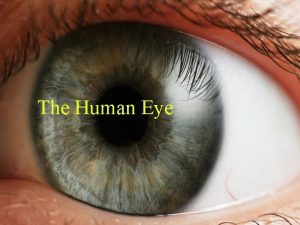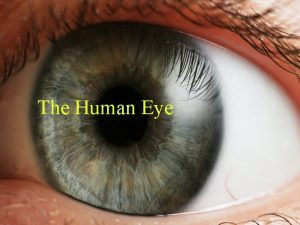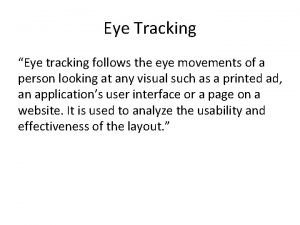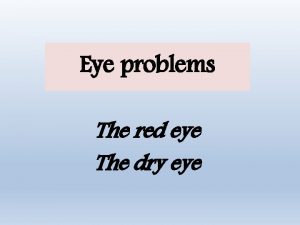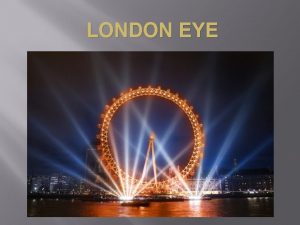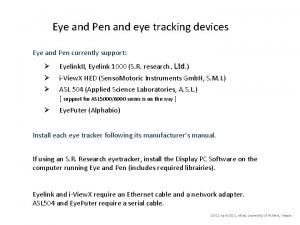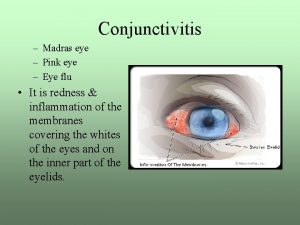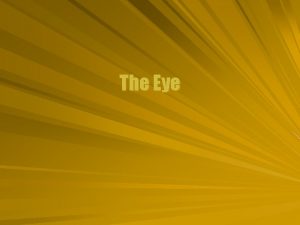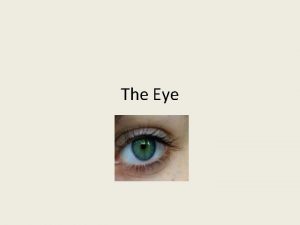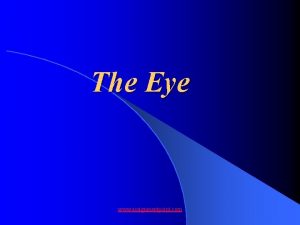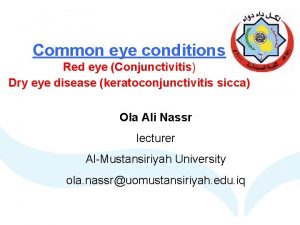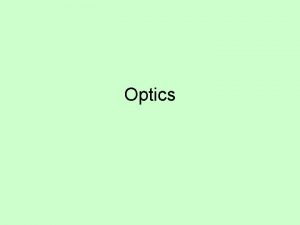CHAPTER 11 The Human Eye The colourful world





































































- Slides: 69

CHAPTER 11 The Human Eye & The colourful world 1

Acknowledgment • Images & video clips have been taken from various sources on the internet. • Some images and video clips have been modified according to the syllabus. Images courtesy: google. com Video clips courtesy: youtube. com Use this presentation for Education purpose only. 2

Human Eye Accommodation Contents Sunrise/Sunset MCQ Defects of eye Refraction through prism Rainbow Twinkling of stars Tyndall Effect 3

Human Eye 4

Retina The light sensitive screen in the human eye is called retina. Retina 5

Cornea is a thin transparent bulged portion of the human eye. Cornea 6

Iris is a dark muscular diaphragm that controls the size of the pupil. Iris 7

Pupil regulates and controls the amount of light entering the eye. Pupil 8

How do we see erect image of an object? The eye lens forms an inverted real image of the object on the retina. The lightsensitive cells in the retina get activated upon illumination and generate electrical signals. These signals are sent to the brain via the optic nerves. The brain interprets these signals, and finally, processes the information so that we see an erect image of the objects. 9

How do we see erect image of an object? 10

Why are we not able to see objects clearly for some time when we enter from bright light? When the light is very bright, the iris contracts the pupil to allow less light to enter the eye. In dim light the iris expands the pupil to allow more light to enter the eye. Thus, the pupil opens completely through the relaxation of the iris. 11

How are we able to see things in a dim-light room? In dim light the iris expands the pupil to allow more light to enter the eye. 12

Crystalline eye lens The crystalline eye lens is a fibrous, jelly-like material which is capable of increasing or decreasing Lens the curvature. 13

Role of Crystalline eye lens The crystalline lens provides the finer adjustment of focal length required to focus objects at different distances on the retina. 14

Seeing far objects The curvature of the lens can be modified by the ciliary muscles. When the ciliary muscles are relaxed, the lens becomes thin. Its focal length increases. This enables us to see distant objects clearly. 15

Seeing far objects 16

Seeing near-by objects When you are looking at objects closer to the eye, the ciliary muscles contract. This increases the curvature of the eye lens. The eye lens then becomes thicker. The focal length of the eye lens decreases. This enables us to see nearby objects clearly. 17

Seeing near-by objects 18

Power of accommodation The ability of the eye lens to adjust its focal length is called accommodation. 19

Least distance of distinct vision The minimum distance, at which objects can be seen most distinctly without strain, is called the least distance of distinct vision or near point of the eye. For a young adult with normal vision, the near point is about 25 cm. 20

Far point The farthest point upto which the eye can see objects clearly is called the far point of the eye. It is infinity for a normal eye. 21

Advantages of having two eyes for vision a) Two eyes gives a wider field of view. b) The ability to detect faint objects is enhanced with two detectors instead of one. c) Two eyes give third dimension of depth. 22

Defects of eye 23

Cataract The crystalline lens of people at old age becomes milky and cloudy. This condition is called cataract. 24

Defects of eye Three common refractive defects of vision. (i) Myopia or near-sightedness, (ii) Hypermetropia or far - sightedness, (iii) Presbyopia. 25

Myopia or near-sightedness Myopia is a common defect of the eye in which a person is able to see nearby objects clearly but cannot see distant objects distinctly. The image is formed in front of the retina and not on the retina. 26

Causes for Myopia may be caused due to: (i) Excessive curvature of the eye lens. (ii) Elongation of the eyeball. 27

Correction of Myopia can be corrected by using a concave lens of suitable power. 28

Hypermetropia or far-sightedness is a common defect of the eye in which a person is able to see distant objects clearly but cannot see near-by objects distinctly. The light rays from the near-by objects are focused at a point behind the retina. 29

Hypermetropia or far-sightedness 30

Correction of hypermetropia Hypermetropia can be corrected by using a convex lens of suitable power. 31

Presbyopia is a common defect of the eye in which a person finds it difficult to see nearby objects comfortably and distinctly without corrective eye-glasses. It is caused when the power of accommodation of the eye decreases with ageing. Presbyopia arises due to the gradual weakening of ciliary muscles and diminishing flexibility of the eye lens. 32

Presbyopia 33

Refraction through prism 34

Prism A triangular prism is a transparent material which has two triangular bases and three rectangular lateral surfaces. It is a device used in the laboratory to show splitting of white light into seven colours. 35

Angle of Prism The angle between the two lateral faces of a prism is called the angle of the prism. 36

Angle of deviation of Prism The angle between the incident ray and the emergent ray is called angle of deviation of the prism. 37

Spectrum The band of the coloured components of a light beam is called spectrum. S P E C T R U M 38

Dispersion The splitting of white light into its component colours is called dispersion. 39

Cause of Dispersion Different colours of light bend through different angles with respect to the incident ray, as they pass through a prism. 40

Which ray bend the most and the least? The red light bends the least. The violet light bends the most. 41

Dispersion & recombination The first prism P 1 splits the white light into seven colours and the second prism in inverted position, again recombines all colours to produce white light. It happens because dispersion produced by the first prism is reversed by the second prism. 42

Some natural phenomenon 43

Rainbow 44

Rainbow A rainbow is a natural spectrum appearing in the sky after a rain shower. It is caused by dispersion of sunlight by tiny water droplets, present in the atmosphere. A rainbow is always formed in a direction opposite to that of the Sun. The water droplets act like small prisms. They refract and disperse the incident sunlight, then reflect it internally, and finally refract it again when it comes out of the raindrop 45

Rainbow 46

Rainbow 47

Flickering of objects seen through fire Random wavering or flickering of objects seen through a turbulent stream of hot air rising above a fire or a radiator takes place because the air just above the fire becomes hotter than the air further up. The hotter air is lighter (less dense) than the cooler air above it, and has a refractive index slightly less than that of the cooler air. Since the physical conditions of the refracting medium (air) are not stationary, the apparent position of the object, as seen through the hot air, fluctuates. 48

Twinkling of stars The twinkling of a star is due to atmospheric refraction of starlight. The starlight, on entering the earth’s atmosphere, undergoes refraction continuously before it reaches the earth. The atmospheric refraction occurs in a medium of gradually changing refractive index. Since the atmosphere bends starlight towards the normal, the apparent position of the star is slightly different from its actual position. The star appears slightly higher (above) than its actual position when viewed near the horizon. This apparent position of the star is not stationary, but keeps on changing slightly, since the physical conditions of the earth’s atmosphere are not stationary. 49

Twinkling of stars 50

Why planets do not twinkle? The planets are much closer to the earth, and are thus seen as extended sources. If we consider a planet as a collection of a large number of point-sized sources of light, the total variation in the amount of light entering our eye from all the individual point-sized sources will average out to zero, thereby nullifying the twinkling effect. 51

Early sunrise The Sun is visible to us about 2 minutes before the actual sunrise due to atmospheric refraction. 52

Delayed sunset The Sun sets 2 minutes after the actual sunset because of atmospheric refraction. 53

Why is the colour of the clear sky blue? The molecules of air and other fine particles in the atmosphere have size smaller than the wavelength of visible light. When sunlight passes through the atmosphere, the fine particles in air scatter the blue colour (shorter wavelengths) more strongly than red. The scattered blue light enters our eyes. 54

Why is the colour of the clear sky blue? 55

Tyndall Effect The phenomenon of scattering of light by the colloidal particles is called Tyndall effect. 56

Tyndall Effect 57

On what factor does the colour of the scattered light depend? The colour of the scattered light depends on the size of the scattering particles. Which colour is more effective in scattering of light? Why? Scattering light of shorter wavelengths at the blue end is more effective than light of longer wavelengths at the red end. The red light has a wavelength about 1. 8 times greater than blue light. 58

What colour would the sky appear if earth had no atmosphere? If the earth had no atmosphere, there would not have been any scattering. The sky would have looked dark. The sky appears dark to passengers flying at very high altitudes, as scattering is not prominent at such heights. 59

Why are stop light and danger signals in red colour? The red is least scattered by fog or smoke. It can be seen in the same colour at a distance. Hence stop signal and danger signals are red in colour. 60

(Activity 11. 3) Place a strong source (S) of white light at the focus of a converging lens (L 1). This lens provides a parallel beam of light. Allow the light beam to pass through a transparent glass tank (T) containing clear water. Allow the beam of light to pass through a circular hole (c) made in a cardboard. Obtain a sharp image of the circular hole on a screen (MN) using a second converging lens (L 2). Dissolve about 200 g of sodium thiosulphate (hypo) in about 2 L of clean water taken in the tank. Add about 1 to 2 m. L of concentrated sulphuric acid to the water. What do you observe? In about 2 to 3 minute, fine microscopic particles begin to precipitate. As the sulphur particles begin to form, you can observe the blue light from the three sides of the glass tank. This is due to scattering of short wavelengths by minute colloidal sulphur particles. The colour of the transmitted light from the fourth side of the glass tank facing the circular hole is at first orange red colour and then bright crimson red colour on the screen. 61

Why the sun appears reddish at sunrise and sunset? Light from the Sun near the horizon passes through thicker layers of air and larger distance in the earth’s atmosphere before reaching our eyes. Near the horizon, most of the blue light and shorter wavelengths are scattered away by the particles. Therefore, the light that reaches our eyes is of longer wavelengths. This gives rise to the reddish appearance of the Sun. 62

Why the sun appears reddish at sunrise and sunset? 63

Exercise (MCQ) 64

1. The human eye can focus objects at different distances by adjusting the focal length of the eye lens. This is due to (a) Presbyopia. (b) Accommodation. (c) Near-sightedness. (d) Far-sightedness. 65

2. The human eye forms the image of an object at its: (a) Cornea. (b) Iris. (c) Pupil. (d) Retina. 66

3. The least distance of distinct vision for a young adult with normal vision is about: (a) 25 m. (b) 2. 5 cm. (c) 25 cm. (d) 2. 5 m. 67

4. The change in focal length of an eye lens is caused by the action of the: (a) Pupil. (b) Retina. (c) Ciliary muscles. (d) Iris. 68

END Prepared by Girish. N, Bengaluru 9844217032 69
 Colourful sentence for class 1
Colourful sentence for class 1 Colourful semantics adjectives
Colourful semantics adjectives Comparative de colorful
Comparative de colorful Colourful semantics template
Colourful semantics template Hammurabi
Hammurabi Birds eye view and worm's eye view
Birds eye view and worm's eye view An eye for an eye hammurabi
An eye for an eye hammurabi Pf
Pf Code of hammurabi activity
Code of hammurabi activity An eye for an eye a tooth for a tooth sister act
An eye for an eye a tooth for a tooth sister act Are brown eyes dominant
Are brown eyes dominant An eye for an eye meaning
An eye for an eye meaning Every eye is an eye
Every eye is an eye Human needs and human development chapter 8
Human needs and human development chapter 8 Chapter 8 human needs and human development
Chapter 8 human needs and human development Ap world history chapter 25 africa and the atlantic world
Ap world history chapter 25 africa and the atlantic world Aperture in human eye
Aperture in human eye Resolving power of the human eye
Resolving power of the human eye Construction of the pupil
Construction of the pupil A thin fold of skin that covers and protects the human eye
A thin fold of skin that covers and protects the human eye Introduction of human eye
Introduction of human eye Introduction of human eye
Introduction of human eye Eye labeled
Eye labeled Hát kết hợp bộ gõ cơ thể
Hát kết hợp bộ gõ cơ thể Slidetodoc
Slidetodoc Bổ thể
Bổ thể Tỉ lệ cơ thể trẻ em
Tỉ lệ cơ thể trẻ em Voi kéo gỗ như thế nào
Voi kéo gỗ như thế nào Chụp phim tư thế worms-breton
Chụp phim tư thế worms-breton Chúa sống lại
Chúa sống lại Môn thể thao bắt đầu bằng từ chạy
Môn thể thao bắt đầu bằng từ chạy Thế nào là hệ số cao nhất
Thế nào là hệ số cao nhất Các châu lục và đại dương trên thế giới
Các châu lục và đại dương trên thế giới Công của trọng lực
Công của trọng lực Trời xanh đây là của chúng ta thể thơ
Trời xanh đây là của chúng ta thể thơ Cách giải mật thư tọa độ
Cách giải mật thư tọa độ 101012 bằng
101012 bằng độ dài liên kết
độ dài liên kết Các châu lục và đại dương trên thế giới
Các châu lục và đại dương trên thế giới Thể thơ truyền thống
Thể thơ truyền thống Quá trình desamine hóa có thể tạo ra
Quá trình desamine hóa có thể tạo ra Một số thể thơ truyền thống
Một số thể thơ truyền thống Cái miệng nó xinh thế chỉ nói điều hay thôi
Cái miệng nó xinh thế chỉ nói điều hay thôi Vẽ hình chiếu vuông góc của vật thể sau
Vẽ hình chiếu vuông góc của vật thể sau Nguyên nhân của sự mỏi cơ sinh 8
Nguyên nhân của sự mỏi cơ sinh 8 đặc điểm cơ thể của người tối cổ
đặc điểm cơ thể của người tối cổ Thứ tự các dấu thăng giáng ở hóa biểu
Thứ tự các dấu thăng giáng ở hóa biểu Vẽ hình chiếu đứng bằng cạnh của vật thể
Vẽ hình chiếu đứng bằng cạnh của vật thể Fecboak
Fecboak Thẻ vin
Thẻ vin đại từ thay thế
đại từ thay thế điện thế nghỉ
điện thế nghỉ Tư thế ngồi viết
Tư thế ngồi viết Diễn thế sinh thái là
Diễn thế sinh thái là Dạng đột biến một nhiễm là
Dạng đột biến một nhiễm là Số nguyên là gì
Số nguyên là gì Tư thế ngồi viết
Tư thế ngồi viết Lời thề hippocrates
Lời thề hippocrates Thiếu nhi thế giới liên hoan
Thiếu nhi thế giới liên hoan ưu thế lai là gì
ưu thế lai là gì Sự nuôi và dạy con của hổ
Sự nuôi và dạy con của hổ Khi nào hổ con có thể sống độc lập
Khi nào hổ con có thể sống độc lập Sơ đồ cơ thể người
Sơ đồ cơ thể người Từ ngữ thể hiện lòng nhân hậu
Từ ngữ thể hiện lòng nhân hậu Thế nào là mạng điện lắp đặt kiểu nổi
Thế nào là mạng điện lắp đặt kiểu nổi Human vs non human bones
Human vs non human bones Human development index definition ap human geography
Human development index definition ap human geography Human nouns
Human nouns Frog common femoral vein function
Frog common femoral vein function Holt world history the human journey
Holt world history the human journey












